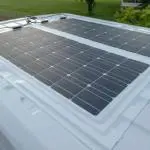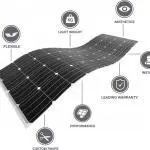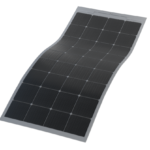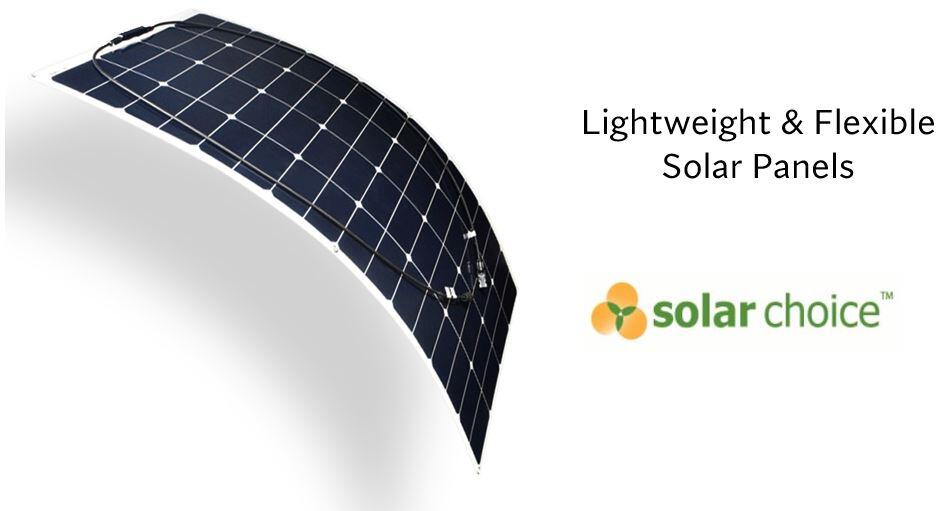We’ve come to expect constant advances in solar power technology. Like computer chips, solar panels tend to consistently increase in power and efficiency while reducing in cost. As market demand increases, the cycle continues.
But when we think about solar panels used for commercial and residential applications, the form (size and weight) of the panels has remained relatively consistent in spite of technology improvements.
This has presented problems for building or home owners when structural issues make it impossible to support an effective and efficient traditional solar array due to weight restrictions.
But with the arrival of lightweight solar panels, that’s about to change.
What are lightweight solar panels?
![]() Lightweight solar cells are made up of silicon wafers sliced down to just a few micrometers wide (compared to 200 micrometers for standard monocrystalline or polycrystalline solar panels). Not only do these panels weigh less than standard panels, but they have increased flexibility, which is why they are also known as flexible solar panels.
Lightweight solar cells are made up of silicon wafers sliced down to just a few micrometers wide (compared to 200 micrometers for standard monocrystalline or polycrystalline solar panels). Not only do these panels weigh less than standard panels, but they have increased flexibility, which is why they are also known as flexible solar panels.
While this technology has been around for a while, research undertaken at MIT has paved the way to move from silicon as the basis for solar cells, and instead use organic materials with electrodes of graphene. This material is lighter, transparent and far less brittle than silicon, offering even more flexibility.
Why might you need lightweight solar panels?
For commercial buildings and residential homes requiring grid-connection, there are a range of benefits offered by lightweight solar panels. These include:
Overcoming structural issues
If a building or home has a roof that is unable to bear the weight of standard solar panels and installation infrastructure, lightweight solar panels provide a good alternative option.
More installation options
Given their lighter weight, and panel flexibility, lightweight solar panels also offer additional installation options on non-traditional surfaces, such as carports or sheds for example.
Faster installation
Lightweight solar panels are easier to carry, move and install, requiring less invasive fixing to any given structure. This means that installation can be completed more quickly, which also provides a cost saving on the installation process.
Compare solar quotes from up to 7 local installers now.
What are some other potential uses for lightweight solar panels?
 Lightweight solar panels are also a great option for off-grid applications. Being up to ten times lighter than standard solar panels, they open up a range of options for solar portability that were previously unsuitable.
Lightweight solar panels are also a great option for off-grid applications. Being up to ten times lighter than standard solar panels, they open up a range of options for solar portability that were previously unsuitable.
In particular, they can be used to replace diesel power in many instances. Applications include:
- Caravans and recreational vehicles
- Boats
- Camping
How do lightweight solar panels perform compared to standard panels?
Standard, rigid solar panels typically have an efficiency rating of between 16 and 20 percent. Currently, lightweight or flexible solar panels offer an efficiency of between 7 and 15 percent, some 25 to 50 percent less.
This means of course that more lightweight solar panels will be needed to generate the same amount of power as a standard rigid panel set-up. So comparatively the cost will be higher for a lightweight solar array, though lower installation costs will offset this to some degree.
The largest obstacle to the need for more solar panels to generate a specified amount of power output is limited space, such as the surface area of a roof.
Performance issues are less apparent for more portable and personal solar applications, such as vehicles and camping.
Like any emerging technology, increased use and further research and development will ultimately bring improved power output and performance.
The pros and cons of lightweight and standard solar panels
When considering between lightweight solar panels and standard solar panels, there are pros and cons to each choice, and which is best will be determined by the requirements of a particular application.
| Lightweight/Flexible Solar Panels | |
| Pros | Cons |
|
|
| Standard/Rigid Solar Panels | |
| Pros | Cons |
|
|
The choice between standard and lightweight solar panels will come down to a range of factors for individual circumstances. For reliable, every day power generation in a fixed location, standard solar panels present the most efficient long-term option.
For portability and use in a variety of different locations, such as on camping trips or on boats, flexible solar panels are a great solution. For commercial and residential usage, lightweight solar panels can also be considered if building structural issues present problems for the installation of a standard solar panel array.
What is the cost difference between lightweight and standard solar panels?
Typically, lightweight or flexible solar panels cost more than rigid solar panels. Offsetting this cost difference to some degree is the reduced cost of installation for lightweight solar panels.
When considering lightweight solar panels for a commercial or residential grid-connected system, the total installed cost of this option would be somewhere in the range of 30 to 40 percent more expensive than for an equivalent rigid solar array.
Not only are the lightweight panels more costly, but due to lower efficiency more panels are needed to match the power output of an equivalent rigid panel system.
Further, when considering the total cost of ownership over the expected lifetime of a solar solution, particularly in commercial and residential grid-connected systems, the shorter lifespan of lightweight solar panels becomes a factor.
This is why they have a shorter warranty period, and if the panels are to be used long-term for, say, residential power generation, the replacement cost of the full array (and potential replacement of damaged panels in addition to this) should be factored into the lifetime expected cost of the solar solution.
It can be difficult to compare the costs between lightweight and standard solar panels due to different sizes and power outputs. A handy rule of thumb is to calculate the ‘per watt’ cost to standardise the comparison of different types of solar panels from various manufacturers.
Can you purchase lightweight solar panels in Australia?
Lightweight solar panels are available in Australia for a variety of applications.
For grid-connected commercial and residential use, options include:
 eArc: New, ultra-light, glass-free solar technology that offers durability and robustness, while being 70 percent lighter and 95 percent thinner than standard rigid solar panels. These panels also significantly reduce installation time on-site. More information here.
eArc: New, ultra-light, glass-free solar technology that offers durability and robustness, while being 70 percent lighter and 95 percent thinner than standard rigid solar panels. These panels also significantly reduce installation time on-site. More information here.
 Verditek: Offering a wide range of lightweight, flexible solar panels, including for commercial and residential use, Verditek solar panels are 10 time lighter than standard solar panels while harvesting the same amount of power. Panels are also very low profile (less than 3mm thick) and can bend due to the use of polymer in manufacturing. Although available for projects in Australia, Verditek is not currently approved by the Clean Energy Council. More information here.
Verditek: Offering a wide range of lightweight, flexible solar panels, including for commercial and residential use, Verditek solar panels are 10 time lighter than standard solar panels while harvesting the same amount of power. Panels are also very low profile (less than 3mm thick) and can bend due to the use of polymer in manufacturing. Although available for projects in Australia, Verditek is not currently approved by the Clean Energy Council. More information here.
For portable, off-grid solar solutions, there are many options available in the Australian market for applications including remote power generation, vehicles, boats and camping.
Talk to an expert about lightweight solar for commercial projects
